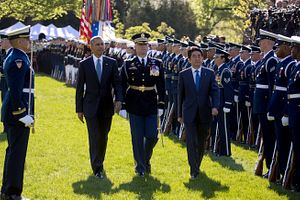The United States and Japan on Monday took one significant step further towards closer security cooperation in the increasingly contested Asia-Pacific, issuing new defense guidelines that lay the foundations for a more expansive approach to regional threats.
The 24-page document published by the Pentagon revised previous defense guidelines the two governments adopted in 1997, adding new criteria that allow for coordinated military actions.
The announcement, which came while Japanese Prime Minister Shinzo Abe is on a state visit to the U.S., aimed to strengthen Tokyo’s economic and military ties with Washington. It has also quickly angered China, which has been aggressive in modernizing its military and taking up territorial disputes in the past few years. Responding in Beijing Tuesday, Chinese Foreign Ministry Spokesman Hong Lei said the U.S. and Japan are responsible for ensuring their alliance does not harm the interests of a third country, like China, or regional peace and stability.
The new guidelines appeared to take a more liberal interpretation of when the two governments should activate a series of readiness measures to deter a potential attack. Previously, the measures were to be enforced only when an attack against Japan is “imminent.” In the latest guidelines, they will be applied as long as an attack is “anticipated.”
In the case of an actual attack, the guidelines clarified scenarios for the U.S. and Japanese militaries to jointly respond to ground, air, maritime, ballistic missile and cross-domain offensives.
Although not specified, the guidelines provided a basis for many cases where U.S. and Japan could confront China – the regional power most capable of carrying out attacks – over disputed islands in the East China Sea.
“If the need arises, the Self-Defense Forces will conduct operations to retake an island,” the guidelines said. Backed by forward-deployed U.S forces, they can take necessary actions including “operations to prevent and repel airborne and seaborne invasions, amphibious operations, and rapid deployment.”
This wording will certainly displease China, since it applies directly to the Senkaku/Diaoyu island dispute between Tokyo and Beijing.
The guidelines would allow the U.S. to back Japan’s actions to defend its airspace, some of which overlaps a newly established air defense identification zone that China created in 2013.
These highly targeted scenarios are inevitably seen as a means to counter China’s heavy investment in developing its anti-access/area denial strategy – an investment that has entailed sophisticated ballistic missiles, anti-ship submarines, and new fighter jets – even though both U.S. and Japan would deny any connection.
Also included in the new guidelines was cooperation on cyber security. Beijing’s rapid advances in cyber technology have prompted regular accusations from the U.S. and its allies of intrusions and espionage.
The guidelines would also permit Japan to respond to scenarios where attacks occurred against a third country, potentially enabling it to take part in South China Sea issues, where other U.S. allies are confronting Beijing over territorial issues. This came as Abe’s administration approved a resolution last July that opened the door for Japan to send troops overseas and abandon its postwar pacifist policy.
The new guidelines came after U.S. Secretary of Defense Ashton Carter recently said that America’s “newest” and “best” things are being deployed to the region, in a seemingly desperate move to assure allies of commitments to regional security.
Both U.S. and Japan insisted the guidelines were merely serving defense purposes that fit an ever-challenging environment rather than provoke any party. “We don’t think that a strong U.S.-Japan alliance should be seen as a provocation,” Obama told a joint White House press conference with Japanese Prime Minister Shinzo Abe, when asked how Beijing should view their relationship. “As I’ve said before, we welcome China’s peaceful rise.”
China’s Foreign Ministry noted that the U.S. and Japan did notify Beijing before publishing the guidelines. Now that they have been published, the two allies could soon expect pushback from Chinese military and foreign policy hawks who have long suspected any U.S. alliance with its Asian allies of being designed to contain China’s rise. Of course, that pushback will be contained by the growing areas of U.S.-China cooperation, recently extended to China’s ongoing anti-corruption campaign.
Kevin Wang is a researcher for CNN’s editorial oversight team in Atlanta. The views here are his own.

































